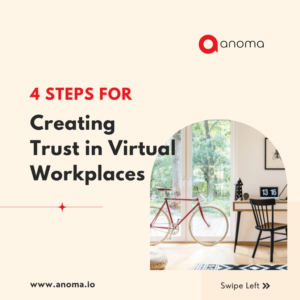- November 1, 2022
- Posted by: Author Anoma
- Categories:

“ Successfully working from home is a skill, just like programming, designing, or writing. It takes time and develops that skill ’’ — Alex Turnbull
Building trust presents unique challenges when Virtual Workspace – Anoma Tech We no longer have the in-person casual and spontaneous interactions with colleagues the watercooler conversations that helped us cultivate trusting relationships over time.
Leaders typically build trust through intuition, which works well for more experienced business professionals. However, there are advantages to a more systematic approach, and it is critical in our new virtual workplaces.
Trust is made up of three parts: benevolence, competence, and honesty. With an understanding of these components, you can take simple and practical steps to increase the level of trust you instill in your virtual staff and colleagues.

Benevolence:
Leaders who establish positive work relationships care about others and consider and value their employees’ interests. And this is the most important factor in determining the level of trust a workplace leader has. Informal interactions that help build trusting relationships must be intentionally replaced in the Virtual Workspace – Anoma Tech
“ Remote work offers flexibility, and we appreciate work-life-balance that comes with that ’’ — Jess Scott
Schedule a weekly meeting with remote team embers; simply connect and see how they are doing. Focus on the person rather than their tasks when establishing rapport. It is critical to show concern for others rather than push for results, especially during times of crisis and high uncertainty.

Competence:
The demonstration of a leader’s on-the-job expertise and ability also contributes to trust in leadership. In virtual teams, where people can feel disconnected, strong communication is an especially important leadership skill, one that will be used to judge your competence and build or destroy trust.
“ People today really value workplace flexibility & remote work because it allows them to focus their energize on work and life as opposed to commuting ’’ — Ken Metos
Tell us what you do not know. It is impossible to know everything. Pretending that you do will result in the opposite of what you want to avoid: a lack of confidence in your abilities. Leaders who ask for help draw others to them through this display of humanity, inspire others by making them feel needed, and gain trust and followers.

Honesty:
Sincerity and follow-through on commitments are the final components of trust. Leaders must say exactly what they mean and mean exactly what they say.

When you first form a new team, trust appears to be simple. Swift trust is a concept that applies to groups of people who are working together for the first time or on short-term projects.
“ Technology now allows people to connect anytime, anywhere, to anyone in the world, from almost any device ” — Michael Dell
Building trust in virtual teams requires thought and planning,
Employees want flexibility, but they do not want to be isolated. Managing a remote team and Virtual Workspace – Anoma Tech learning how to build trust can be difficult for managers.

Virtual Workspace – Anoma Tech
However, by implementing the proper practices, you can create a team that is even happier and more productive than one that meets every day.
read more at www.anoma.io
